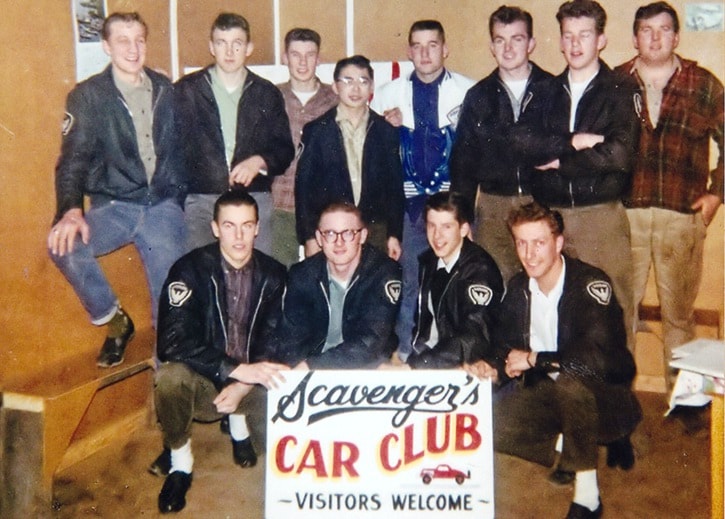Editor’s note: Following is the first of a two-part series on the Scavengers Car Club.
Like an apple blossom to bees, the Royalite sign sat atop a tall post along Highway 97 enticing truckers, motorists and tourists to its service station south of the city.
The fast-food chains had not yet flooded the Okanagan and quick snacks were pretty well restricted to the North End Drive-In and Grace’s Dairy Drive-In (The Dip) on Mission Hill. So, in addition to fuel for their vehicles, Vernon locals were occasionally drawn to the garage’s attached coffee shop for informal meetings and refreshment breaks.
One autumn afternoon in 1960, it was for those very purposes that four teenagers — Doug Hayhurst, Andy Hoglund, Russ Mendenhall, and Eddy Yamada — gathered at a table inside the Royalite’s cafe.
The conversation among the quartet led to the idea of the formation of a car club, a group activity that had become increasingly popular in North America. Before they had emptied their first java refill, the Scavengers Car Club was born, its name derived from the popular chromed and flared Scavenger tail pipe.
At that meeting, it was decided that Russ Mendenhall would become its first president. Then, armed with an agreement that camaraderie was to be the main focus of the club, the founding foursome set forth on a vigorous membership drive. Their quarry: young males in possession of a valid driver’s licence whose only other possible roadblock to becoming part of the group was lack of acceptance by all current members. From that first small assembly, the Scavengers Car Club would evolve to become a unique menagerie of close, loyal friends.
Members of other car clubs appeared to share a strong common interest in automobiles and some of those clubs were organized by enthusiasts around a specific type of vehicle. Owning a car was usually a prerequisite to membership. But that was not to be with the Scavengers — money was scarce so car ownership was not essential. Even those who wished to join but were not mechanically inclined, would be welcome to just hang out and benefit from the repairs, maintenance and learning opportunities provided by the natural “nuts and bolts” DIYers within the group.
In the months that followed the membership drive, the parking area outside their meeting place would be filled with an unusual assortment of vehicles: from dad’s brand new ‘60 Pontiac to a ‘48 Ford Coupe, ‘53 Ford sedan, a Metropolitan Nash, ‘51 Austin A40, a British Ford Prefect, and a grey Fargo fruit-hauling pickup with a red box. Leaning against the outside wall of the clubhouse was an old motorcycle that could occasionally be coaxed into sputtering to life.
Upon acceptance, along with a membership card, every Scavenger was provided with several “Courtesy on the Roads” cards. Each member was expected to offer assistance to any hapless motorist he may have come upon in his travels and hand out one of those cards with the Scavengers name on it once his good deed was done.
Promoting safety on the highway was one of the purposes of the club and all Scavengers were encouraged to set a good example in the operation of a vehicle. One method of self-policing used by the club to encourage traffic law obedience was the “Mystery Cop.” Through a method of secrecy, a “cop” was appointed each month. At the end of his term, the spy would reveal himself and point out any club offenders he had observed not upholding the Motor Vehicle Act. In a kangaroo court setting, it was left up to the rest of the members to determine the amount of the fine to be imposed. You just never knew, while out for a drive, whether “big brother” was the guy beside you, or had spotted you downtown going through an amber light!
Mainly descendants of blue-collar workers, club members weren’t strangers to physical labour. When Doug Hayhurst received permission from his parents to renovate an old storage shed on their farm property on Dixon Dam Road, it wasn’t long before it was turned into a clubhouse. Most of the necessary building material was scavenged (pun intended), but fines and initial membership fees weren’t enough to cover administrative costs. It was obvious that the club had to come up with some money-making ventures.
Andrew Maksymchuk is a writer in Vernon, B.C.
